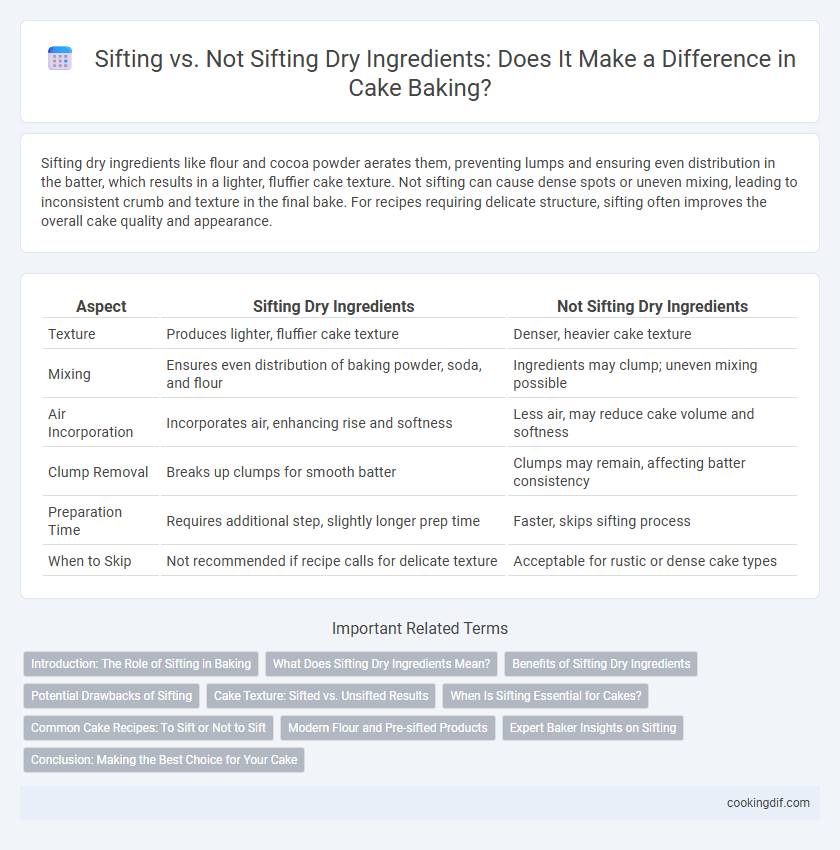Sifting dry ingredients like flour and cocoa powder aerates them, preventing lumps and ensuring even distribution in the batter, which results in a lighter, fluffier cake texture. Not sifting can cause dense spots or uneven mixing, leading to inconsistent crumb and texture in the final bake. For recipes requiring delicate structure, sifting often improves the overall cake quality and appearance.
Table of Comparison
| Aspect | Sifting Dry Ingredients | Not Sifting Dry Ingredients |
|---|---|---|
| Texture | Produces lighter, fluffier cake texture | Denser, heavier cake texture |
| Mixing | Ensures even distribution of baking powder, soda, and flour | Ingredients may clump; uneven mixing possible |
| Air Incorporation | Incorporates air, enhancing rise and softness | Less air, may reduce cake volume and softness |
| Clump Removal | Breaks up clumps for smooth batter | Clumps may remain, affecting batter consistency |
| Preparation Time | Requires additional step, slightly longer prep time | Faster, skips sifting process |
| When to Skip | Not recommended if recipe calls for delicate texture | Acceptable for rustic or dense cake types |
Introduction: The Role of Sifting in Baking
Sifting dry ingredients like flour, cocoa powder, and baking soda aerates them, ensuring even distribution and eliminating lumps, which contributes to a lighter cake crumb. When dry ingredients are not sifted, clumps can cause uneven mixing and dense, uneven texture in the final cake. Proper sifting enhances the chemical reactions during baking, promoting optimal rise and consistent taste.
What Does Sifting Dry Ingredients Mean?
Sifting dry ingredients involves passing flour, baking powder, cocoa, or powdered sugar through a fine mesh sieve to break up clumps and aerate the mixture, ensuring a lighter, more uniform batter. This process improves ingredient distribution, which is crucial for consistent texture and proper rise in cakes. Skipping sifting can lead to dense cakes with uneven pockets of leavening agents or flour.
Benefits of Sifting Dry Ingredients
Sifting dry ingredients like flour, cocoa powder, and baking powder ensures even distribution of leavening agents, preventing clumps and promoting a uniform rise in cakes. It aerates the ingredients, resulting in a lighter, fluffier cake texture by incorporating air into the batter. This process improves the mixing efficiency, reducing the risk of overmixing and producing a more tender crumb.
Potential Drawbacks of Sifting
Sifting dry ingredients like flour and cocoa powder can introduce more air and cause lighter cakes, but it may also lead to ingredient loss and inconsistent measurements. Over-sifting can break down delicate starches and gluten, negatively impacting cake texture and structure. Skipping sifting saves time and ensures stable ingredient ratios, though it risks clumps that affect batter evenness.
Cake Texture: Sifted vs. Unsifted Results
Sifting dry ingredients aerates the flour and evenly distributes leavening agents, resulting in a lighter, fluffier cake texture with finer crumb. Unsifted ingredients can lead to denser, heavier cakes due to uneven mixing and potential clumps of baking powder or cocoa powder. Consistently sifting ensures uniform ingredient incorporation, enhancing the cake's rise and tender mouthfeel.
When Is Sifting Essential for Cakes?
Sifting is essential for cakes made with delicate flours like cake flour or when incorporating powdered sugar to ensure a light, airy texture and prevent lumps. Recipes involving leavening agents such as baking powder or baking soda benefit from sifting to evenly distribute these ingredients and promote even rising. Dense cakes or those using coarser flours like whole wheat typically do not require sifting, as it has minimal impact on texture.
Common Cake Recipes: To Sift or Not to Sift
Sifting dry ingredients like flour, baking powder, and cocoa powder aerates them, resulting in lighter, fluffier cakes commonly favored in recipes such as sponge cakes and chiffon cakes. Many muffin and dense cake recipes like pound cakes often skip sifting, as the denser batter benefits from the unaltered ingredient texture for proper moisture retention. When following common cake recipes, adhering to the sifting instructions helps achieve the intended crumb structure and rise, improving overall cake quality.
Modern Flour and Pre-sifted Products
Using modern flour or pre-sifted products reduces the necessity of sifting dry ingredients, as these flours are already finely milled and aerated for consistent texture and measurement accuracy. Skipping the sifting step can save time without compromising the cake's crumb structure or rise when using these products. However, for vintage or coarser flours, sifting remains crucial to prevent clumps and ensure even distribution of leavening agents.
Expert Baker Insights on Sifting
Expert bakers emphasize sifting dry ingredients such as flour, cocoa powder, and baking soda to aerate and evenly distribute them, ensuring a lighter texture and more consistent crumb in cakes. Not sifting can lead to clumps and uneven mixing, which negatively impacts the cake's rise and texture. Sifting also helps incorporate air, contributing to a fluffier and more tender cake that meets professional baking standards.
Conclusion: Making the Best Choice for Your Cake
Sifting dry ingredients like flour, cocoa powder, and baking powder aerates the mixture, which leads to a lighter, fluffier cake texture and helps distribute leavening agents evenly. Skipping sifting can result in denser cakes with uneven crumb due to clumps and uneven ingredient distribution. For the best cake outcome, sifting is recommended when recipes call for it, especially in delicate or layered cakes where texture and rise are crucial.
Sifting vs Not sifting for dry ingredients Infographic

 cookingdif.com
cookingdif.com